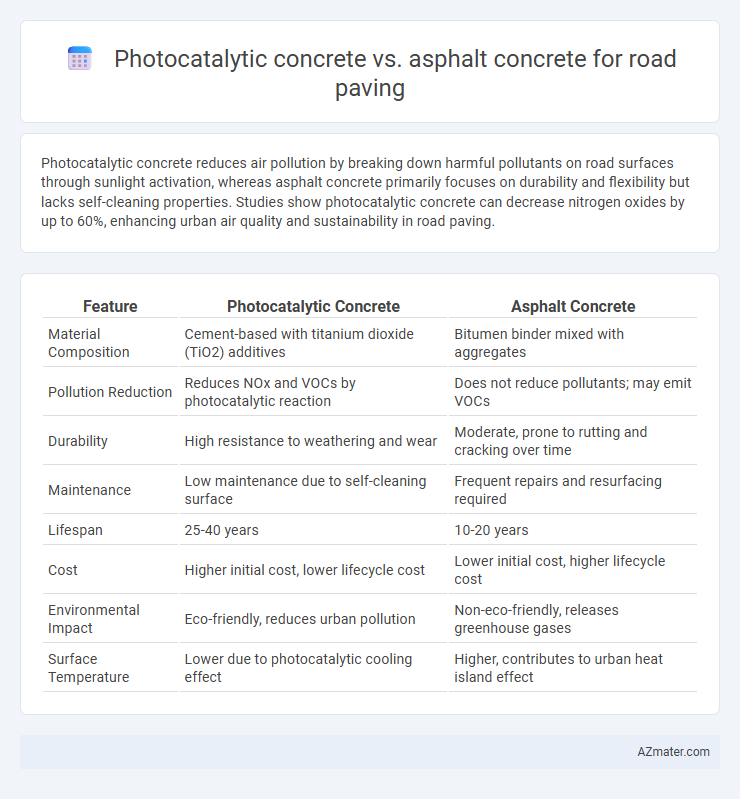Photocatalytic concrete reduces air pollution by breaking down harmful pollutants on road surfaces through sunlight activation, whereas asphalt concrete primarily focuses on durability and flexibility but lacks self-cleaning properties. Studies show photocatalytic concrete can decrease nitrogen oxides by up to 60%, enhancing urban air quality and sustainability in road paving.
Table of Comparison
| Feature | Photocatalytic Concrete | Asphalt Concrete |
|---|---|---|
| Material Composition | Cement-based with titanium dioxide (TiO2) additives | Bitumen binder mixed with aggregates |
| Pollution Reduction | Reduces NOx and VOCs by photocatalytic reaction | Does not reduce pollutants; may emit VOCs |
| Durability | High resistance to weathering and wear | Moderate, prone to rutting and cracking over time |
| Maintenance | Low maintenance due to self-cleaning surface | Frequent repairs and resurfacing required |
| Lifespan | 25-40 years | 10-20 years |
| Cost | Higher initial cost, lower lifecycle cost | Lower initial cost, higher lifecycle cost |
| Environmental Impact | Eco-friendly, reduces urban pollution | Non-eco-friendly, releases greenhouse gases |
| Surface Temperature | Lower due to photocatalytic cooling effect | Higher, contributes to urban heat island effect |
Introduction to Photocatalytic and Asphalt Concrete
Photocatalytic concrete incorporates titanium dioxide (TiO2) nanoparticles that activate under sunlight, breaking down pollutants and enhancing air quality alongside traditional structural functions. Asphalt concrete, composed of bitumen binder and mineral aggregates, offers flexibility and durability for road surfaces, effectively absorbing stresses from traffic loads. The integration of photocatalytic materials into concrete presents an innovative approach to sustainable urban infrastructure by combining mechanical performance with environmental benefits.
Composition and Structure Comparison
Photocatalytic concrete incorporates titanium dioxide (TiO2) nanoparticles within its cement matrix, enabling air-pollution reduction through photocatalysis, while asphalt concrete consists primarily of bitumen binder mixed with aggregates, providing flexibility and resistance to deformation. The porous microstructure of photocatalytic concrete enhances light penetration and catalytic activity, contrasting with the dense, viscous nature of asphalt that limits catalytic reactions but offers superior waterproofing and smooth surface characteristics. Photocatalytic concrete's rigid, cementitious structure promotes durability and self-cleaning features, whereas asphalt's viscoelastic properties accommodate thermal expansion and contraction for improved crack resistance.
Photocatalytic Properties and Benefits
Photocatalytic concrete incorporates titanium dioxide (TiO2) nanoparticles that activate under sunlight to break down pollutants like nitrogen oxides (NOx), improving urban air quality. This photocatalytic property enables self-cleaning surfaces that reduce maintenance costs and extend pavement lifespan compared to traditional asphalt concrete. Furthermore, photocatalytic concrete helps mitigate heat island effects by reflecting more sunlight, enhancing environmental sustainability in road paving applications.
Environmental Impact Assessment
Photocatalytic concrete significantly reduces air pollution by breaking down nitrogen oxides (NOx) through titanium dioxide additives, which helps improve urban air quality during road paving. Asphalt concrete, while durable and cost-effective, contributes to the urban heat island effect due to its dark color and higher thermal conductivity, increasing local temperatures and energy consumption. Life cycle assessments reveal photocatalytic concrete's potential to lower overall environmental impact by mitigating air contaminants despite higher initial production energy requirements compared to conventional asphalt.
Durability and Longevity Analysis
Photocatalytic concrete demonstrates superior durability compared to asphalt concrete due to its enhanced resistance to environmental degradation and self-cleaning properties, which mitigate surface wear and pollutant accumulation. Asphalt concrete tends to deteriorate faster under UV exposure and temperature fluctuations, leading to frequent maintenance and reduced lifespan. Studies indicate photocatalytic concrete can extend road longevity by up to 30% through its photocatalytic titanium dioxide content that reduces crack propagation and surface aging.
Cost Efficiency and Maintenance Needs
Photocatalytic concrete offers cost efficiency by reducing long-term maintenance expenses through its self-cleaning and pollution-degrading properties, which minimize surface degradation and cleaning requirements compared to traditional asphalt concrete. Asphalt concrete generally has lower initial installation costs but requires more frequent maintenance and resurfacing due to wear, oxidation, and rutting, increasing lifecycle costs. Investing in photocatalytic concrete can offset higher upfront costs by extending pavement lifespan and lowering the frequency of repairs and environmental remediation efforts.
Air Quality Improvement Potential
Photocatalytic concrete incorporates titanium dioxide, which actively breaks down nitrogen oxides (NOx) and other pollutants, significantly enhancing air quality along urban roadways compared to traditional asphalt concrete. Studies demonstrate that photocatalytic surfaces can reduce airborne NOx concentrations by up to 40% under optimal sunlight exposure, making them highly effective in mitigating traffic-related air pollution. Asphalt concrete lacks these self-cleaning properties, resulting in limited impact on atmospheric pollutant reduction in urban environments.
Urban Heat Island Mitigation
Photocatalytic concrete significantly reduces surface temperatures in urban environments by reflecting sunlight and breaking down pollutants through its titanium dioxide components, effectively mitigating the Urban Heat Island (UHI) effect. In contrast, traditional asphalt concrete absorbs and retains heat, contributing to higher ambient temperatures and exacerbating UHI impacts. Studies demonstrate that integrating photocatalytic concrete in road paving enhances air quality and lowers urban temperatures, offering a sustainable solution for city infrastructure.
Application Suitability for Different Climates
Photocatalytic concrete, embedded with titanium dioxide, excels in urban environments with high pollution and intense sunlight, as it actively breaks down airborne contaminants while maintaining durability in moderate to warm climates. Asphalt concrete performs well in colder regions due to its flexibility and ability to resist cracking under freeze-thaw cycles, making it suitable for climates with frequent temperature fluctuations. Both materials offer distinct advantages based on climate conditions, with photocatalytic concrete favoring pollution reduction in sunny areas and asphalt concrete providing resilience in colder weather.
Future Trends and Innovations in Road Paving
Photocatalytic concrete integrates titanium dioxide to reduce air pollution, offering self-cleaning properties and enhanced durability compared to traditional asphalt concrete. Innovations focus on improving photocatalyst efficiency and combining recycled materials to create sustainable, long-lasting pavements that mitigate urban heat island effects. Future trends emphasize smart road surfaces with embedded sensors and adaptive materials that enhance safety, environmental benefits, and infrastructure resilience.

Infographic: Photocatalytic concrete vs Asphalt concrete for Road paving
 azmater.com
azmater.com